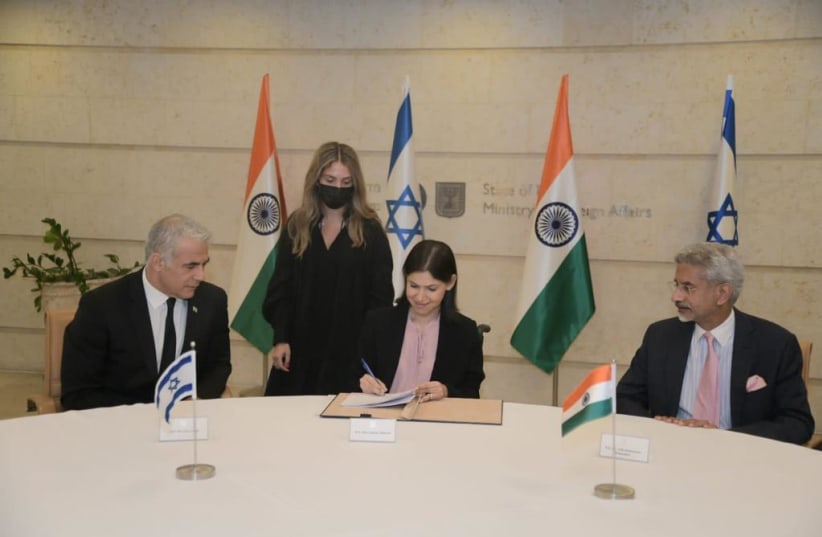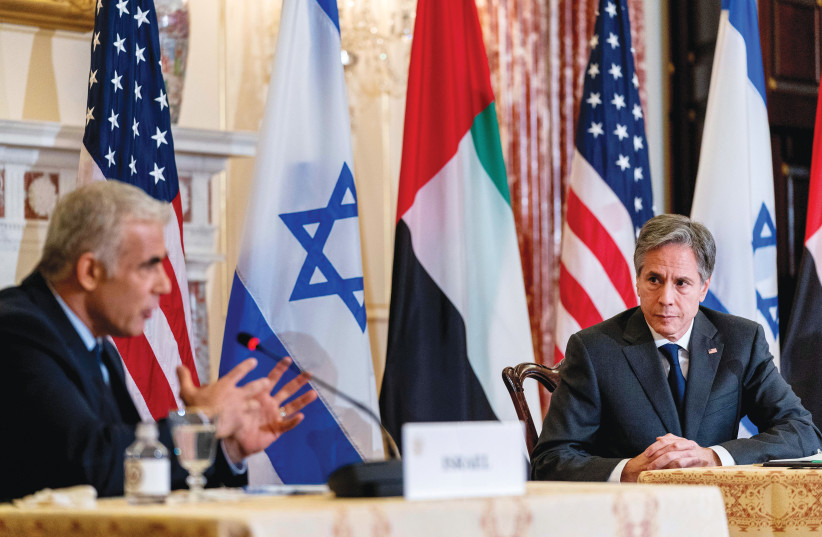This week’s visit of Indian Foreign Minister Subrahmanyam Jaishankar and a subsequent virtual meeting with US Secretary of State Antony Blinken, UAE Foreign Minister Sheikh Abdullah Bin Zayed Al Nahyan and Foreign Minister Yair Lapid marks a new stage in Israel’s diplomatic relations. It represents a rare example of Israel as part of a group of countries, as opposed to the usual bilateral relationships that Jerusalem usually enjoys.
The meeting is also important because it represents the quiet formation of a group of like-minded countries. Added to this list should also be Greece, France, Cyprus, Bahrain, Egypt, Jordan and some other countries that share common interests, either in the Eastern Mediterranean or as part of a bloc of stability and moderation.
It is important to note that Lapid was just in Washington, where his visit went well. This is part of a growing series of visits not only by Lapid, but also by other key Israeli officials. The US-Israel relationship is not new, though; what is new is adding on to it a series of other relationships.
This is special because in the past, even when Israel had close ties with countries like the US, these were often ties that were not always seen as part of America’s larger goal in the region.
That is why Israel was part of the US’s European Command for many years and separated from the region in many international circles due to opposition by the Arab League, Iran or other states. That began to change decades ago with the end of the Cold War, but the change has been slow.
Public meetings between former prime minister Benjamin Netanyahu or his team with officials in Jordan or Egypt were almost unheard of, despite the stories of “good relations behind the scenes.” Countries can’t conduct foreign policy “behind the scenes” forever. NATO wouldn’t have been able to operate if it was just a “secret” alliance behind the scenes.
Groups of countries function well together when they are robust and open about their work and project power and influence. When they cease to do that or become too large, then they become unremarkable and large organizations, such as the Organization of American States or the Organization of African Unity.
Israel is at a crossroads – a time of pivot in the region and internationally. Consider that Israel is also hosting the Blue Flag exercise this week, with participants from around the world, including the US, Germany, France, Italy, India, the UK and Greece. When we look at that group, we again can see India, the US, Greece and Israel, as well as France, Germany and Italy.
France and Israel have good relations with Greece, and they share interests in the Mediterranean. Israel also shares interests via the Eastern Mediterranean gas forum and potential East Med pipeline. France and Greece recently signed a new defense pact.
India and Israel have enjoyed strategic relations for years. There is also a close relationship between Israel’s defense industry and India. However, that relationship can be leveraged with the US, and Israel’s new ties with the UAE, to become a stronger relationship. Of course, each country enjoys other relationships that may not always be unified.
For instance, India has amicable relations with Iran, while Israel and China have had decent relations over the years. The US has increased its objections to Israel-China ties, concerned over Beijing investment in Israel or how that might impact close defense and intelligence ties between Israel and the US. Meanwhile, India and China have often been at odds.
What might come next in this story? There are economic and defense-industry advantages to the new ties and the ability to synergize the network of ties between Washington, Jerusalem, Abu Dhabi and New Delhi. That means the whole can be more than the sum of its parts.
“Around this virtual table, there is a unique set of capabilities, knowledge and experience that can be used to create the network that we all want to see created,” Lapid said at the meeting.
More important meetings will occur soon. The Knesset speaker will be in Athens on October 20, according to reports. He will have meetings with his Greek counterpart, the head of the Greek parliament’s Greece-Israel Friendship Group and the chairman of parliament’s Standing Committee on National Defense and Foreign Affairs. Other important meetings will take place.
India’s foreign minister was also in Greece in June. This illustrates how close ties already intersect between Israel, Greece, India and the UAE, as well as the US and France.
The concept of a four-country partnership is enshrined in the existing “quad” countries – India, Japan, Australia and the US. These countries have conducted joint naval drills and work together on other issues. Meanwhile, the US, Australia and UK have signed on to Aukus, another pact; and the US, UK, New Zealand, Canada and Australia together form the “Five Eyes” intelligence network.
Foreign Ministry Director-General Alon Ushpiz praised the idea of having India more involved in opportunities in the region, and he praised the Abraham Accords as a “strategic earthquake,” The Times of India reported. The article mentioned potential cooperation on vaccines, emerging technology, climate change and security. That could also mean new frontiers, such as artificial intelligence and big data, Ushpiz said.
Times of India thought a “second Quad” might be forming. It remains to be seen if this is the case. What matters is that the first steps toward this widened understanding of a partnership that links India and Israel with the US and UAE and potentially Greece, Cyprus, Jordan, Bahrain, Egypt, France and others is a key to the stability of the region and an arc of stability running from Washington via Paris and Athens to Jerusalem via the Gulf to New Delhi and on to Australia and Japan.
Considering Israel’s movement into Central Command this year, it might also be worthwhile noting that the arc of countries sketched out here contrasts with the 2004 book The Pentagon’s New Map, by Thomas P.M. Barnett.
In that book of grand strategy, written during the height of the global war on terrorism, he characterized the “functioning core” of the world as being North America, Europe, Japan, Australia, China, India, South Africa, Brazil, Argentina, Chile and Russia. The unstable part of the world, or “non-integrated gap,” consisted of a swath of countries from the Middle East to Central Asia and parts of Africa.
Nowadays, if you look at the line that connects Greece and Cyprus to Israel, Egypt, Jordan, the Gulf and India, what you find is a key set of countries that may finally turn the corner in terms of this concept of a “gap” of stability. The gap has meant extremism and challenges.
It is also where US global hegemony appears to have run aground, as symbolized by the US leaving Afghanistan, and where near-peer rivals, such as Russia and China, as well as regional states that oppose US policy, such as Iran and Turkey, are growing in power.
That may be where the US-UAE-Israel-India connection comes together most of all in presenting a moderate alternative to the aggressive, extremist and authoritarian countries.

